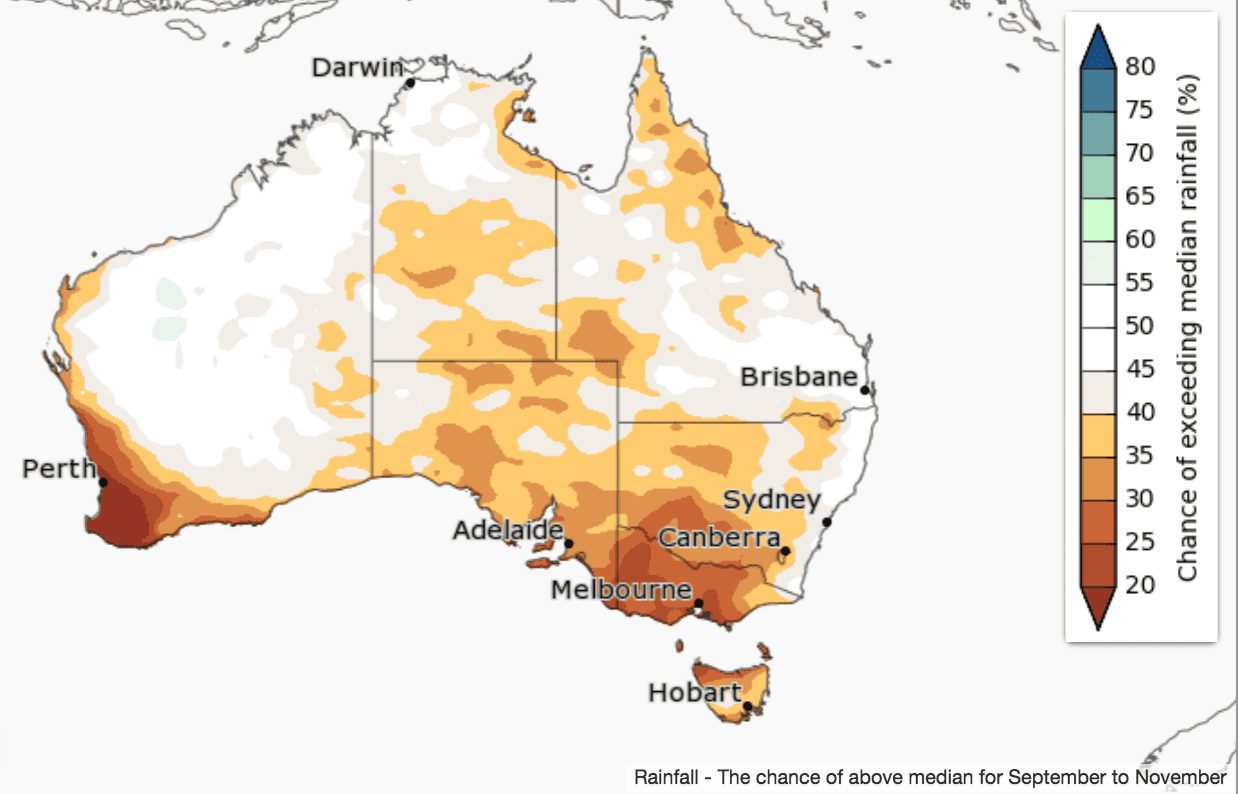IT WILL surprise most people to learn that the driest continent on earth is not Australia.
That dubious distinction goes to Antarctica, which is both the driest and windiest of the seven continents. Antarctica is actually considered a desert, courtesy of the extreme cold which freezes all of the water.
However, Australia can lay claim to being the driest inhabited continent in the world.
That fact was certainly borne out by the Bureau of Meteorology (BOM) in their latest climate outlook which was released on August 30. They forecast the spring months (September to November) are more likely to be drier than average across almost all of the Australian winter cropping districts.

To rub salt into an already drought infected wound, daytime temperatures are likely to be warmer than average and the frost danger period in the south is expected to extend further into the spring than normal.
The tropical Pacific Ocean temperatures have also been warming in recent months and a continuation of this trend will increase the likelihood of an El Niño event developing later in the spring. The BOM says that the risk of El Niño developing is double the normal level. To the north-west of this vast dry land, cooling ocean temperatures mean that a positive Indian Ocean Dipole (IOD) may also develop in the spring months, strengthening the effects of El Niño should it develop.
Sorghum/irrigation key
One prediction from the BOM that has gone relatively unnoticed is the timing of the first wet season rains in northern Australia. They predict that these will arrive later than normal. This will, of course, have a huge impact on the size of the sorghum plant, and ultimately production.
Sorghum is an important component of the feed grain balance sheet in eastern Australia. In a dry season such as this, it is critical. With an average sorghum crop, the eastern Australian grain deficit for the 2018/19 season will be at least 3 million tonnes (Mt). Any decrease in sorghum production adds to this shortfall.
The size of the sorghum crop also depends quite heavily on irrigation. The expectation of below average rainfall combined with extremely dry soils means that low streamflows are likely to continue in the south-east of the country throughout the spring. With the water level in many storage facilities in eastern Australia already well below average for this time of year, the availability of irrigation water for the summer crop programs in New South Wales and Queensland will be a limiting factor.
Cattle feedlot utilisation set to fall
Compounding the potential feed grain deficit in the eastern states, was a substantial increase in the number of cattle on feed in the second quarter of the calendar year. They increased by 9 per cent, or almost 95,000 head to 1.12 million head. This is a new national record, with increases recorded in all states except Western Australia.
Strong demand for quality Australian beef and the worsening drought conditions have undoubtedly contributed to this explosion. With feedlot utilisation at 86 per cent of capacity, the pressures on all parts of the supply chain are enormous. Increasing feed grain prices are just one of these pressures with lotfeeding margins certainly being squeezed dramatically at the moment. Tight margins and an expected decrease in the availability of suitable cattle later in the year all point to a reduction in numbers in the fourth quarter and into next year.
Eastbound movements
All of these factors add to an already increasing reliance on states with an exportable surplus of cereal grains, namely South Australia and Western Australia, to fill the east coast supply void.
“the dependence on Western Australia is increasing daily”
With crop conditions and production now deteriorating quite quickly in Victoria and parts of South Australia, the dependence on Western Australia is increasing daily.
Any demand shortfalls in southern New South Wales, and now Victoria, will have to be satisfied by road and/or rail out of South Australia. This will decrease the quantity of grain available for shipment to east coast consumers out of South Australian ports. In droughts past, the Eyre Peninsula has been a common origin for such shipments due to its isolation from a road and rail freight viewpoint. However, there are now substantial production issues arising in parts of the Eyre Peninsula as well.
The increased reliance on Western Australia is definitely being reflected in the shipping stem activity. Each week, bookings are added, and they are almost solely destined for transshipment through the ports of Brisbane, Newcastle, and now Port Kembla. The latest numbers suggest that third quarter discharges at the aforementioned ports will exceed 900,000t.
With spring upon us, we have now entered critical phases of both the winter and summer cropping cycle. Substantial rain across the entire country is essential for both. The next four to eight weeks will determine winter crop production and the spring sorghum plant. These, in turn, will determine the magnitude of the west to east transshipment task ahead of the grain industry here in Australia over the next fourteen months.
The article was written by Peter McMeekin who is a consultant to Grain Brokers Australia

HAVE YOUR SAY